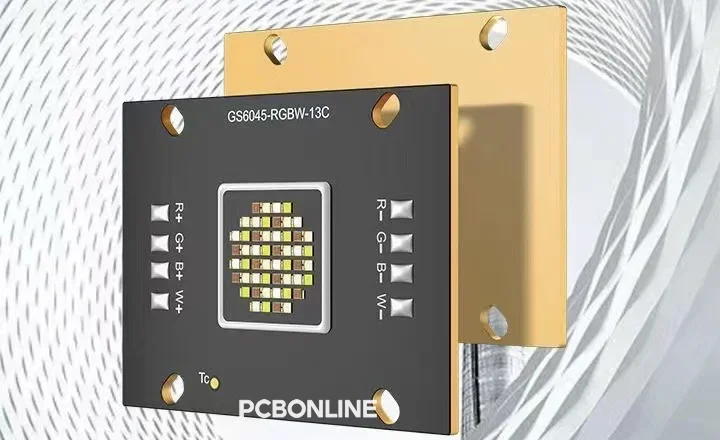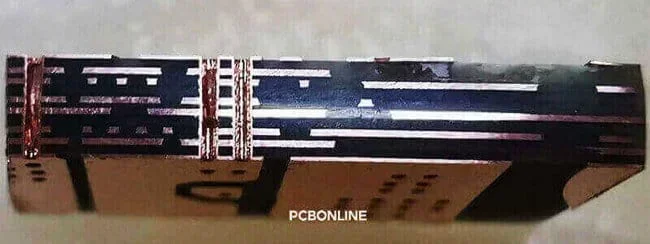
The high power of electrical products leads to great thermal dissipation. Otherwise, the electronic components, such as LEDs and ICs, will lower the efficiency and even burn. In thermal dissipation from components, the printed circuit board substrate plays a key role.
Heat transfers from the component pins to the PCB copper circuit layer, prepreg layer, then the PCB substrate. The PCB substrate transfers heat to the mechanical box and the air.
As electronic products' power is getting higher, FR4 PCBs may not meet thermal dissipation requirements. There are 3 types of high thermal conductivity PCBs - copper base PCBs, aluminum PCBs, and ceramic PCBs that you can consider for power PCB design.
Part 1. Copper Base PCB - 1W/mK to 9W/mK or 398W/mK
PCB substrate: copper
Thermal conductivity: regular 1W/K to 9W/mK, thermoelectric separation 398W/mK
PCB structure: circuit layer, prepreg, copper base
PCB layer: 1 to 8
Applications: high-power LED lighting, electricity systems, lighting for new-energy cars, UV lights, communication, and medical electronics
![]()
Copper base PCB or copper core PCB is a high thermal conductivity PCB using a copper plate as the substrate. Copper has a thermal conductivity of 398W/mK, but the regular copper base PCB has a thermal conductivity of 1W/mK to 9W/mK. Even so, it is better than aluminum PCBs.
Regular copper base PCB - 1W/mK to 9W/mK
Why is the thermal conductivity of regular metal core PCBs much smaller than metal? Please check the single-layer regular base PCB structure below.
![]()
You will find that a dielectric layer or prepreg hinders heat transfer. From components to the PCB metal base, heat dissipates quickly in metal, but prepreg is not metal and dramatically lowers the thermal dissipation speed. That's why the thermal conductivity of regular copper base PCBs and aluminum PCBs is 1W/mK to 9W/mK.
![]()
Also, because of the restriction from prepreg, a regular copper base PCB can only reach a limit of a double-sided four-layer structure.
Thermoelectric separation copper base PCB - 398W/mK
However, the copper base PCB can be designed and manufactured in a new way - thermoelectric separation. Copper base PCBs using this technology have the thermal conductivity of copper - 398W/mK!
How is the thermal conductivity of a copper base PCB not reduced by prepreg? Please check the structure of a single-layer copper base PCB below.
![]()
You will find that copper reaches the bottom of the electronic component. Thermal transfers directly from the component to the copper base, and prepreg only insulates the copper base and the circuit layer.
With the thermoelectric separation technology, you can design a copper base PCB to be multilayer to achieve more circuit functions, and the PCB fabricator can manufacture 8-layer copper base PCBs.

Part 2. Aluminum PCB - 1W/mK to 9W/mK
PCB substrate: aluminum
Thermal conductivity: 1W/mK to 9W/mK
PCB structure: circuit layer, prepreg, aluminum base
PCB layer: 1, 2, or 4
Applications: mainly LED lighting
Aluminum PCBs are the cheapest for thermal management solutions. One reason is that aluminum is cheaper than copper, and the other reason is that, usually, aluminum PCBs have a simple structure and are easy to fabricate.
![]()
Usually, aluminum PCBs are single-layer, double-layer with two mounting sides, or double-layer with a mounting side. The limit of aluminum PCBs is a double-mounting-side four-layer structure. Usually, the thermal conductivity of aluminum PCBs is 1W/mK or 2W/mK. But from the PCB manufacturer, you can buy aluminum PCBs with higher thermal conductivity.
We have our laminate factory for aluminum PCBs and strategic collaboration with the laminate company Ventec.
PCBONLINE has achieved industrial 4.0 fully automatic aluminum PCB fabrication, and we reduced the aluminum PCB price to only $39 per square meter.
Part 3. Ceramic PCB - 20W/mK or 180W/mK
PCB substrate: alumina or aluminum nitride
Thermal conductivity: alumina PCB 20W/mK, aluminum nitride PCB 180W/mK
PCB structure: circuit layer, ceramic base
PCB layer: 1 to 4

Applications: high-power LED lighting, automotive sensors, industrial controllers, solar power batteries, high-frequency switches, communication antennas, solid-state relays, etc.
Ceramic PCBs are high thermal conductivity PCBs that use alumina or aluminum nitride as the substrate.
Ceramic has stable mechanical and chemical performances and similar thermal expansion to semiconductors (ICs). The ceramic substrate can also conduct heat quickly from the circuit layer to the mechanical box and the air.
Aluminum nitride PCBs have a thermal conductivity of 180W/mK, while alumina PCBs have a thermal conductivity of 20W/mK. If you need PCBs for high-power devices, ceramic PCBs won't let you down.
From the PCB manufacturer PCBONLINE, you can buy ceramic PCBs with or without prepreg. Please check the two ceramic PCB structures below.
![]()
In the left-side ceramic PCB, the circuit layer and the ceramic substrate are bonded by prepreg. In the right-side ceramic PCB, the circuit layer and the ceramic substrate are directly sintered.
Aluminum nitride and alumina are two common substrates for ceramic PCBs. Besides alumina PCBs and aluminum nitride PCBs, other ceramic PCBs include BeO PCBs, silicon nitride PCBs, and silicon carbide PCBs.
Part 4. One-Stop PCB Manufacturer and Thermal Management Solutions
High-power applications require a good thermal management solution, including PCB design, fabrication, and assembly. The one-stop PCB manufacturer PCBONLINE can provide you with software and hardware building services. Founded in 1999, we have two large PCB manufacturing bases and one PCB assembly factory.
![]()
Here are reasons to work with PCBONLINE for thermal management solutions:
- PCBONLINE provides one-stop high thermal conductivity PCB/PCBA fabrication, including copper base PCBs, aluminum PCBs, and ceramic PCBs.
- Our CAM engineers with 20+ years of experience will provide one-on-one engineering support throughout your high-power PCB project.
- We can customize thermal conductivity for regular copper base PCBs and aluminum PCBs from 1W/mK to 9W/mK.
- Fully automatic aluminum PCB fabrication to reduce your hardware building budget.
- We adopt the DPC technology to realize the 3D design for your ceramic PCBs and customize copper thickness from 1μm to 1mm.
If you haven't designed the PCB, PCBONLINE can also provide high thermal conductivity PCB according to your requirements. For high thermal conductivity PCB fabrication and assembly, please contact PCBONLINE by email at info@pcbonline.com to get a quote.
Frequently asked questions about high-thermal conductivity PCBs
Answer 1: Yes, but you need to spend a lot of effort on the design. At PCBONLINE, our CAM engineer usually separates the electrical network and thermal network so that the board doesn't rely on FR4 to dissipate thermal.
Answer 2: BeO has better thermal conductivity than AlN and Al2O3, but it's toxic to fabricate, so BeO PCB is unavailable from PCBONLINE.
Answer 3: Yes, we can. PCBs with a hybrid-material substrate are a good solution for thermal management. Besides FR4/AlN, we can also fabricate FR4/copper, FR4/aluminum, AlN/copper, alumina/copper PCBs, etc.
© This article is an original work of the PCBONLINE team. Please indicate the author PCBONLINE if you reprint. If the article is reproduced without permission or indicating the author's source, PCBONLINE reserves the right to investigate the infringement.




